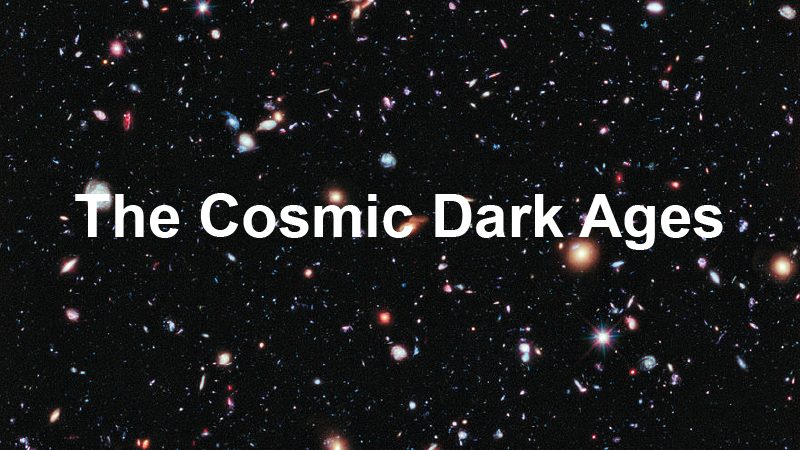The Cosmic Dark Ages
Episode #5 of the course A short history of the universe
Although the universe was as hot as the surface of the sun at the time of recombination (Lesson 4), it quickly cooled as it continued to expand, and the radiation that was released at that time (377,000 years after the Big Bang) became stretched out by expanding space-time until its wavelength was longer than visible light (infrared) and the universe became not only transparent, but literally “dark.” This darkness then lasted for millions of years until the first stars caught fire. These first 800 million years are known as the “Dark Ages” of the universe, not only because of lack of light but also because we have so little knowledge about what happened during this period.
The story we have now about the Cosmic Dark Ages is based mainly on two sources—astronomical observations of the earliest galaxies and quasars, and the cosmic background radiation. The earliest quasars and galaxies are so far away from us that we are seeing them as they were a little less than a billion years after the Big Bang (ya); however, it must have taken millions of years for the first stars to gather together into galaxies big enough for us to see. At the same time, recent observations of the CMB by the European Space Agency’s Planck satellite observatory suggest that this happened around 560 million ya.
One mind-blowing conclusion of scientists studying the Cosmic Dark Ages is that there was a time only 10 to 15 million years into the Dark Ages when the universe had conditions somewhat favorable to life. At this time, the CMB radiation had cooled down to about room temperature, where liquid water could exist. If any stars had evolved and exploded at this time, providing atomic elements heavier than hydrogen and helium, and if any rocky planets had come together, then life could have evolved at this time. Although 15 million ya is long before we can see any stars or planets, that doesn’t mean there weren’t any; they would be too far away, too dim, and too obscured by hydrogen gas for us to see. Some astronomers calculate that dark matter could have made matter come together fast enough for a few stars and planets to form at this time—the “habitable epoch” of the universe.
The timing of events during the Cosmic Dark Ages depends a lot on dark matter, which we know little about, so there is still a lot of room for speculation. However, the outlines of a reliable story are beginning to emerge thanks to the work of astronomers such as Tom Abel, Martin Rees, Volker Bromm, and Avi Loeb using CMB data and computer simulations. They believe that dark matter began to condense first into huge balls, sheets, and filaments, which then attracted hydrogen into clouds. When the balls of dark matter became about 100,000 times more massive than our sun, the hydrogen clouds became dense enough to heat up and radiate away some of their energy, which caused them to cool down and contract until they became dense enough to heat up again until fusion happened—and thus the first stars were born.
Recommended book
Share with friends

